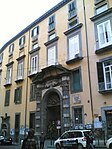Sant'Anna dei Lombardi
1411 establishments in Europe15th-century establishments in ItalyChristian monasteries established in the 15th centuryGothic architecture in NaplesReligious organizations established in the 1410s ... and 3 more
Renaissance architecture in NaplesRoman Catholic churches completed in 1411Roman Catholic churches in Naples

Sant'Anna dei Lombardi, (Italian: St. Anne of the Lombards), and also known as Santa Maria di Monte Oliveto, is an ancient church and convent located in piazza Monteoliveto in central Naples, Italy. Across Monteoliveto street from the Fountain in the square is the Renaissance palace of Orsini di Gravina.
Excerpt from the Wikipedia article Sant'Anna dei Lombardi (License: CC BY-SA 3.0, Authors, Images).Sant'Anna dei Lombardi
Piazza Monteoliveto, Naples San Giuseppe
Geographical coordinates (GPS) Address External links Nearby Places Show on map
Geographical coordinates (GPS)
| Latitude | Longitude |
|---|---|
| N 40.844816 ° | E 14.250525 ° |
Address
Chiesa di Sant'Anna dei Lombardi (Chiesa di Santa Maria di Monteoliveto)
Piazza Monteoliveto
80134 Naples, San Giuseppe
Campania, Italy
Open on Google Maps










